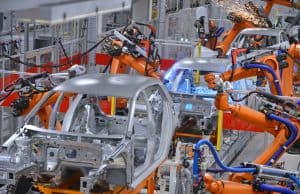
Manufacturing is no longer just about putting items on a boat and going across oceans. It’s about being able to design something and test it before you ever go through that process
With the latest technology, manufacturing is almost indistinguishable from tech or services companies. “Machines as a Service” lays the groundwork for a production-less production process. IoT opens up opportunities to transform into service organizations, and 3D printing means dynamic software-driven design from customers’ keyboards to finished product, in near real-time.
All of this is transforming, or “servitizing,” traditional manufacturing as we’ve known it. Jeff Kavanaugh, head of the Infosys Knowledge Institute, says technology means manufacturers are becoming service companies on many levels. In a recent interview with Knowledge@Wharton, Kavanaugh points out that “manufacturing is no longer just about putting a bunch of sneakers or sheets of metal on a barge or a boat and going across oceans. It’s about being able to 3D-print a product somewhere. It’s about being able to design something and test it before you ever go through that process.”
See also: Business Benefits from Industrial IoT, at Long Last?
This is not happening because manufacturers want glitzy new technology — it’s a matter of survival, he continues. It’s no longer about plants and production lines — it’s about speed. “In a world where it takes a long time to build a plant or a factory and set up these supply chains, you’ve got these factors or disruptors that are happening much more quickly.”
Manufacturers have a competitive asset that can ease this transition to servitization, Kavanaugh says — it’s data. If you bought a product, you had information on its usage, and the manufacturer was completely cut off. “What if, through low-cost sensors and Internet and integration, now the manufacturer knows about it?” he posits. “It can let you know when something might fail. It can let you know when maybe there’s a change in regulation or compliance or safety.” As a result, the relationship between the company and the customer evolves into a continuous, even 24×7 relationship. “Manufacturers can change the definition of what a product is, change the nature of their relationship and even start to have value from the information that the product is generating.”
Kavanaugh has recommendations for making the transformation to servitization. For starters, the revenue picture for services associated with products is still murky at best. “Taking advantage of technology, instrumenting, and embedding, doesn’t guarantee you’ll make any money,” he says. “Just because you can do something doesn’t mean someone is willing to pay for it.” That’s why it’s important not to abandon traditional economic or customer models during the transition. “Embedded sensors and connectivity and cloud and AI aren’t by themselves making this happen or will make you money. They’re tools.”
Data ownership is another matter companies need to address. “That’s a challenge in this brave new world of connectivity. What are the boundaries, what are the responsibilities, and what are the legal ramifications?”
Kavanaugh observes there’s a reluctance to move too fast into digital-driven servitization. “The companies that early on experimented and experimented frequently, they developed the scar tissue. They learned through small mistakes and small wins. They understood what worked for them, what worked in the factory, what worked on the shipping dock, what worked in the retail showroom.” another issue is scaling these efforts, he adds. “How do you scale the experiments and the proofs of concept, because then you’re dealing with things that aren’t just technical. They’re cultural. They cross organizational boundaries. And unless the very most senior people in the company address it, you’re down to silos. You’re down to people competing, maybe the different vice presidents or at different organizational levels.”
The bottom line is sticking to the basics of business, starting with knowing and being open with customers, Kavanaugh says. “Have transparency. That’s an overused word, but have transparency and let people know there’s not some nefarious agenda, which is why the social media companies have run into some trouble recently. Even if what they’re doing overall is net-positive, it can come across in a negative way. Who owns the information? Why are you collecting this?”
Technical issues that need to be addressed include enabling systems to talk to one another, and embedding sensors in their plants and equipment and they can talk to their trading partners.
Ultimately, customers need to buy in with enthusiasm. “Be creative and find new ways to excite people. I think that’s what’s important. Turn it into an experience.”




























